It’s extremely uncharitable to take a look back at 2019-20 and declare it anything other than a success for Leicester. Yes, Champions League qualification looked likely for most of the season, and to miss out was ultimately a disappointment, but the trajectory and outcome were more than fine.
In Brendan Rodgers’ first full season in charge, Leicester built on a strong run at the back end of 2018-19 to finish fifth. Since their unexpected title win in 2015-16, the team has turned over managers at a rapid rate but also contrived to stabilise and grow. Finishes of twelfth, ninth and ninth have now been exceeded and in raw terms the team improved ten points season to season. This meant it was still their second most successful Premier League season and while not quite the 40 point year to year boost that made them champions, the original baseline they moved upwards from was higher and the likelihood of maintaining a good level surely is too.
In a season of two halves, Leicester ballooned over what were solid metrics pre-Christmas then found their run deflated despite continuing solid metrics from there on in. They scored 39 points in the first 19 games with a plus-22 non-penalty goal difference and plus-8 expected goal difference, then 23 points from the last 19 with plus-7 for non-penalty goals and plus-10 for xG. Wait a minute? Very similar expected numbers in both halves of the season? Yes, and that's why sometimes, outcomes can be deceptive.
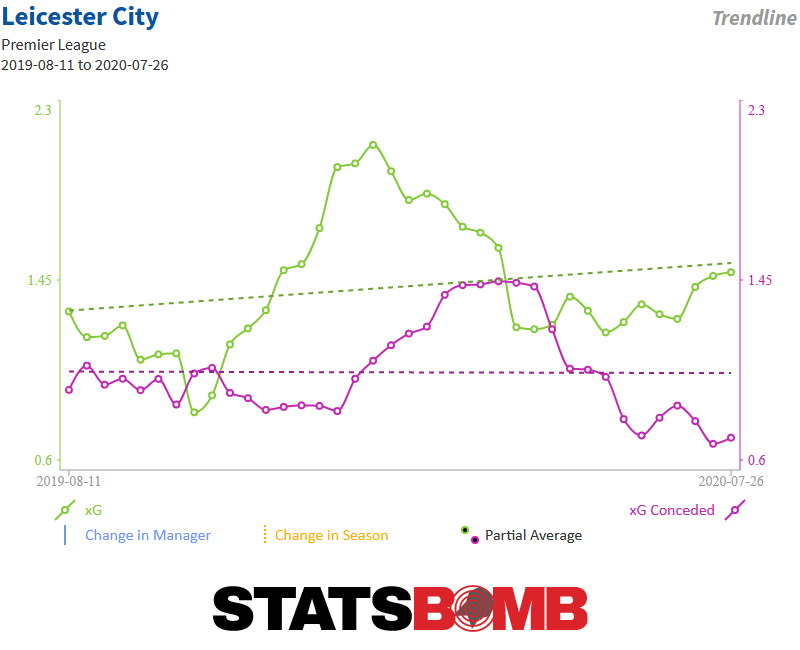
Overall, it's impossible to take a negative stance on their metrics. Expected goal difference? Fourth. In attack? Fourth. Defence? Fifth. Leicester got the cusp of the top four not by some fluke but by playing football of a quality that merited their position.
What made Leicester good last season? To start, Brendan Rodgers got them working pretty hard off the ball:
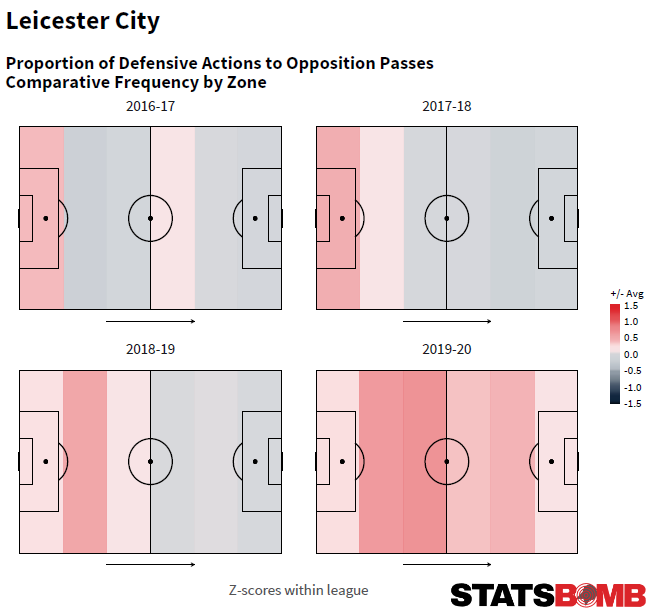
That chart includes StatsBomb pressure events alongside other "traditional" defensive metrics (tackles and the like). It shows that in proportion to their opponent's pass volumes, Leicester were either slightly or quite frequently above average in how they engaged in every zone of the pitch--a notable change from previous seasons. The old school pass per defensive action metric (not pressure, just high up the pitch) had Leicester logged as lowest (best) across 2019-20 and consistent over each half of the season. The proportion of opponent receipts that were pressed within two seconds, had Leicester at 28% in the first half of the season (2nd) and 27% in the back half (1st). Outside of Manchester City, Liverpool and to a degree, Chelsea, the teams that enact a press that shows up well in data are Leicester and Southampton. This team puts in a shift.
Part of what enabled this is that the role and purpose of players in Rodgers' line-ups were fairly consistent and clear. There is a sense of Liverpool in how Leicester partition their contributors into attackers than use possessions and defenders that don't, not least insofar as the two full-backs, Ricardo Pereira and Ben Chilwell fitted firmly into the attacking band. Alongside James Maddison, this trio finished the most Leicester possessions during 2019-20, and it's easy to presume that missing these three in the run in was costly. Once Maddison was unable to feature, Rodgers seemed more inclined to work with three centre backs, pushing the full-backs ever higher, perhaps knowing he didn't have another Maddison-type, as an attempt to further embellish the full back attacking contribution. Of course by now, Pereira's loss to an ACL in March cut deep, for all that Justin did a solid job in covering, and Chilwell was later missed too with 19 year old Luke Thomas covering. Pre-lockdown, the team had been injury free and consistent with a version of 4-1-4-1 most commonly used. Barnes, Tielemans and Perez contributed a fairly democratic attack looking to power Vardy's Indian summer, while Wilfried Ndidi sat in front of the centre backs and covered everything going the other way.
Personnel
It's to Leicester's credit that ever since their title win, they've sold a big ticket star every summer to a big six club, yet managed to build and maintain a fairly solid squad and compete well against exactly those teams. N'Golo Kanté and Danny Drinkwater and now Chilwell all went to Chelsea, Riyad Mahrez to Manchester City and Harry Maguire to Manchester United. This reliable income has been a useful counterbalance to necessary spending and has meant that they have made a bunch of mid-priced bets along the way. More recently they have quite often come out the right side of the deals. Youri Tielemans was the most expensive (at around £40m) but elsewhere Ndidi, Maddison, Caglar Söyüncü and Pereira have forged good careers at Leicester and were core parts of last season's team. Even players that have not become core starters such as Kelechi Iheanacho, Dennis Praet or James Justin are now able to round out the squad and offer useful depth, while it's always fun to find a Harvey Barnes or Hamza Choudhury lurking in your development squads.
None of these players are anywhere near being the wrong age and most of them are still on the cusp of their best years. The squad has a lot of pre-peak talent that has grown together. The veterans here are two title winners in keeper Kasper Schmeichel and Vardy and a still effective Jonny Evans. who has now spent five seasons post-Manchester United proving their decision to move him on to be not optimal. With this kind of age profile, there is no obvious reason why this team shouldn't be as good if not better this coming season:
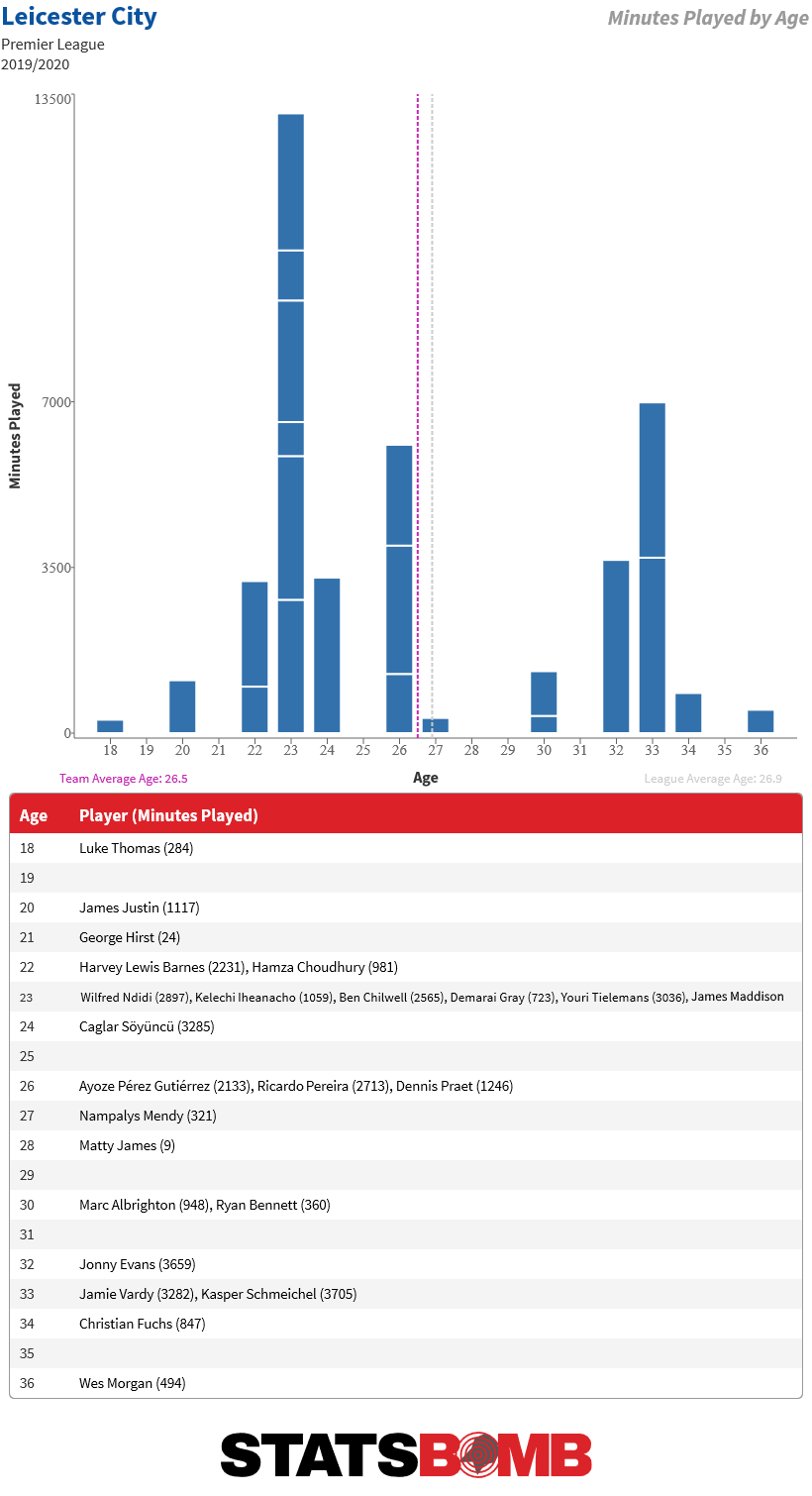
With Chilwell departing, a replacement was quickly sought. Signing a player from Atalanta does have a ring of "hipster's choice" to it but Timothy Castagne represents another right age (24) mid-range fee (£21.5m) with a decent amount of experience in a good side. He has covered either flank as a full back; he's spent time fairly equally on both sides across the last two seasons but with Pereira (if fit) and James Justin already ensconced on the right side it seems most likely that he'll be stationed on the left. Remaining left full back Christian Fuchs is surely winding down at 34 so it's not impossible they will strengthen again here, but Castagne's profile is that of a player who is slightly more secure on the ball than Chilwell, while not contributing to the attack in the same way.

Castagne also doesn't offer the ball carrying high up the pitch or as a general outlet that Chilwell did, so there may be tweaks afoot in the style Leicester play:
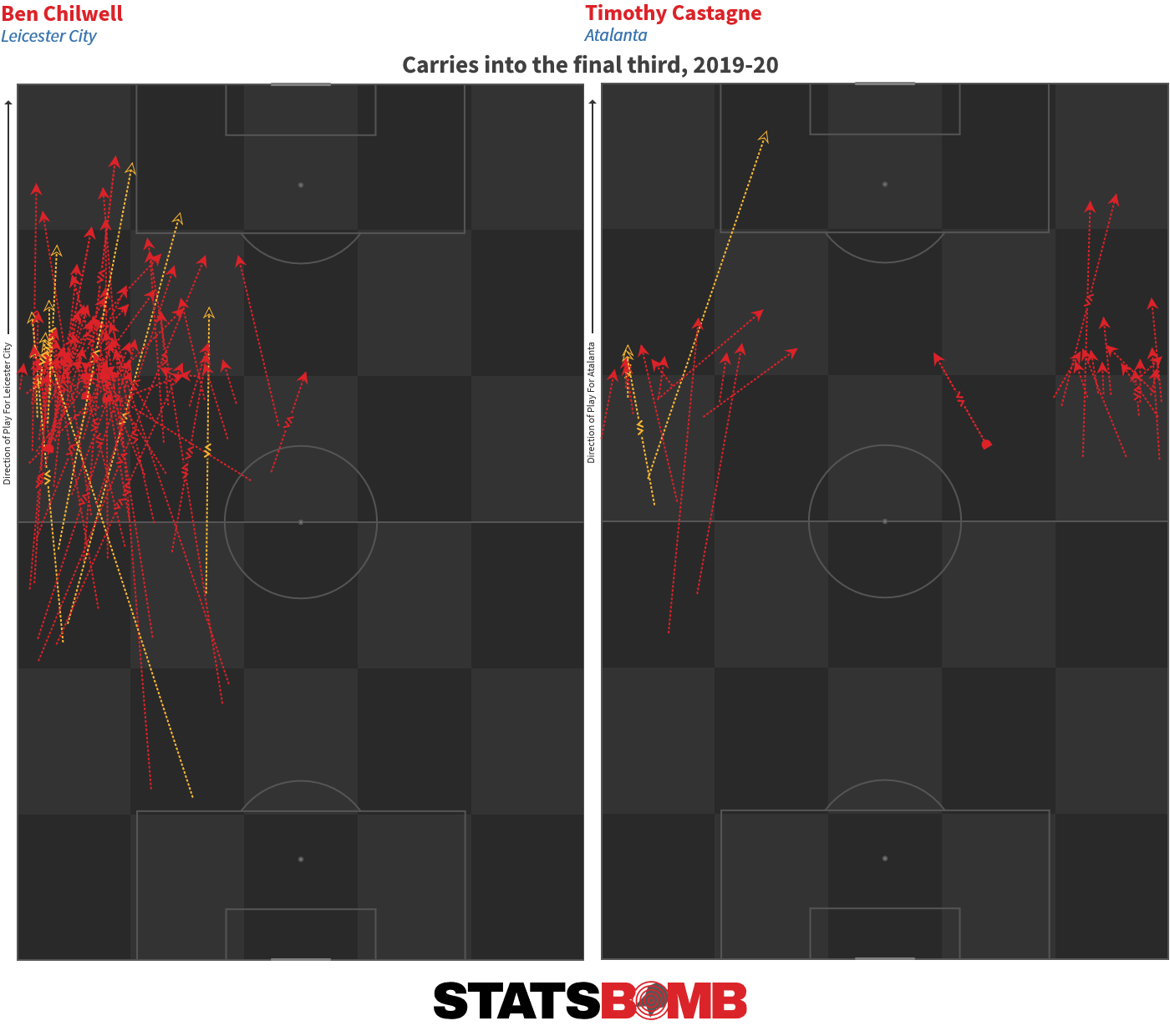
Elsewhere, Vardy remains somewhat immune to his age, and Rodgers has managed to extract his best goalscoring form in some seasons, by targeting shrewder movement and utilising his speed to get on the end of throughballs:
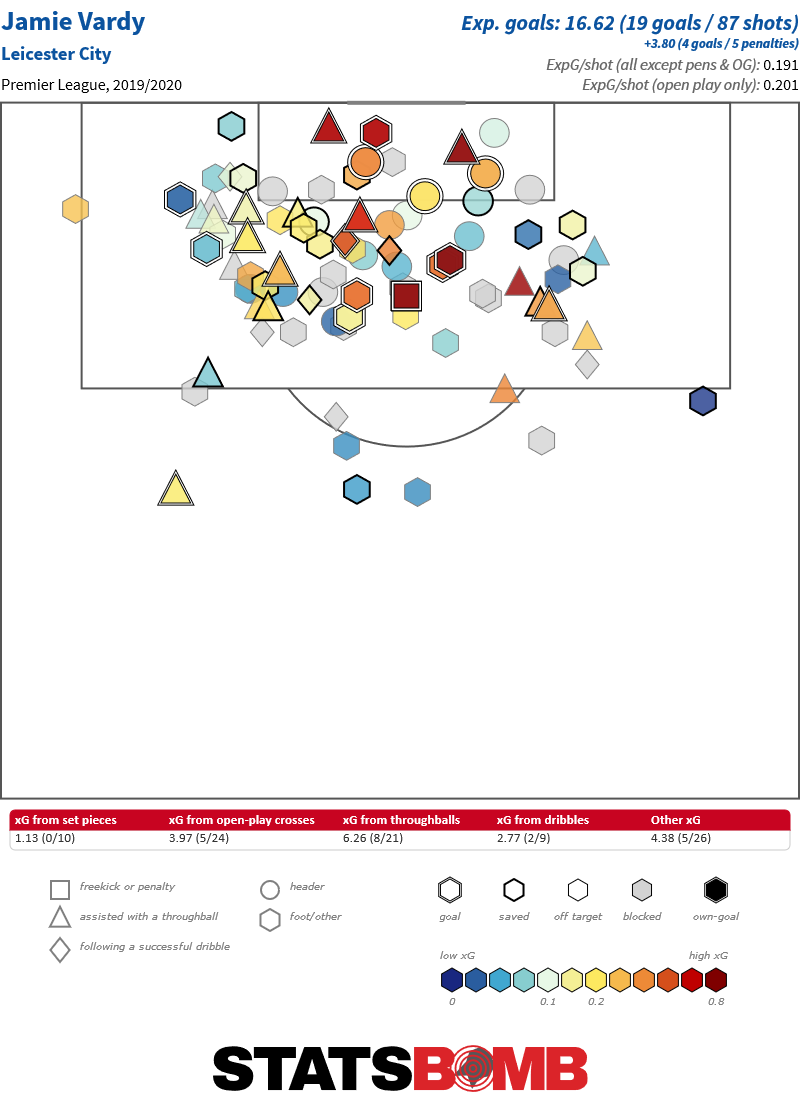
Vardy can be a streaky finisher, but in the aggregate he remains reliably over expectation. One day he will need replacing and there's an argument that for team effectiveness in buildup he's a net minus. Solving that is probably a decision for further down the line though, as his inevitable goal contribution will always be hard to replicate from elsewhere.
Projection
With the full backs contributing so heavily to Leicester's success in 2019-20, then Chilwell leaving and Pereira suffering a serious injury, it may be hard to mimic the specific set-ups we saw from August to March. Finding the balance here may well be crucial to whether Leicester can get early results, with further issues around the time until Maddison returns to full fitness and Evans missing the start of the season through suspension. A trip to Manchester City aside (they offered next to nothing in both fixtures last season), Leicester's early schedule is not unkind and they will hope that their injured stars can work their way back into contention once the schedule bites a little more. European football does focus consideration towards squad depth, and a couple more incoming players would help.
Results trending in the wrong direction (6-5-8 second half of the season, 2-3-4 post Covid break) have led to a divergent view of how good this team is and how well it can perform in 2020-21. The opening Sporting Index lines had them at around 56 points, behind all of the big six and Wolves, but the facts remain that in tied positions this team took close to 60% of all shots, for 60% of xG and scored over 60% of the goals. To ignore that entirely would negate the reality of Leicester's achievement.
As a metrics loyalist, I feel obliged to come out on the positive side of predicting Leicester. But for nagging doubts about key injuries i'd be confident that they could compete more than adequately against teams widely rated higher than them who have shown far less appeal in the numbers such as Arsenal and Tottenham. Their age profile is perfect for that of a team that can continue to progress, and this group of players is reminiscent of that which Mauricio Pochettino helmed for Tottenham at the start of their good run in the mid 2010s; a team which ironically found Leicester in their way perhaps a year or two before they hit their own peak. High praise? Sure, but there is talent throughout this team and there isn't that much that needs to be done to compete for a top four slot again.
If you're a club, media or gambling entity and want to know more about what StatsBomb can do for you, please contact us at Sales@StatsBomb.com
We also provide education in this area, so if this taste of football analytics sparked interest, check out our Introduction to Football Analytics course
Follow us on twitter in English and Spanish and also on LinkedIn
